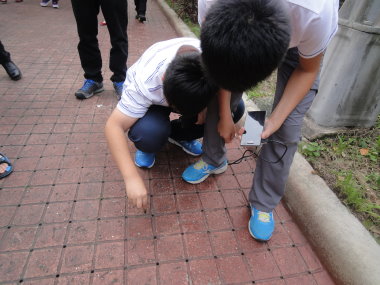Motive
Process
- Research Team
- Selection of Topic
- Interviews
- Transcripts
- Field Observation
- Surveys
- Project Framework
- Design Layout
- Game Design
- Drafting of Content
- Translation
Game Time
Process
★Field Observation
To gather more information for our CyberFair research, there were two main places we visited for the field observation: Limen Village in Xizhi and the Xindian Water Resources Agency.

After visiting the breathing road, also called the sponge road, in Xizhi, we noticed the temperature on this road was cooler than that on other roads. However, we also discovered a few shortcomings of the sponge road. For example, some of the holes, referred to as pores of the JW Pavement, on the sponge road were blocked by dirt. From this, we realized no matter how good an invention is, it still has some shortcomings. The effects of these shortcomings can be reduced by regular maintenance, allowing the invention to maximize its functions and potential.
At the Water Resources Agency, we saw several different facilities, such as an indoor rainfall simulator, pavement temperature sensor, and a machine for assessing the water permeability of pavements. The primary types of pavement tested and studied at this facility are porous asphalt pavement, grass bricks, permeable bricks, and the JW Eco-Technology Pavement. The testing process is standardized by observing the degree of infiltration, pavement temperature, humidity level, and load-bearing capacity of these different methods of pavement.
Our visit of the Xindian Water Resources Agency opened our eyes to how unique the JW Eco-Technology is compared with other types of pavement. In addition, we are able to better understand how JW Eco-Technology works in practice by observing the sponge road at the Limen Village in Xizhi.
By Iris Chen